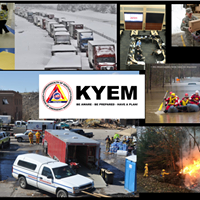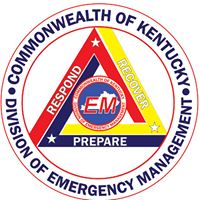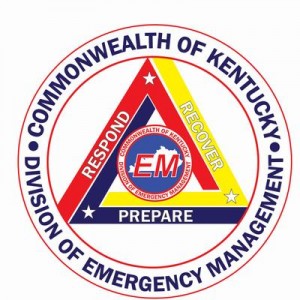 In conjunction with National Preparedness Month, Gov. Matt Bevin has proclaimed September as Preparedness Month in Kentucky.
In conjunction with National Preparedness Month, Gov. Matt Bevin has proclaimed September as Preparedness Month in Kentucky.
Kentucky Emergency Management urges Kentuckians to “BE AWARE – BE PREPARED – HAVE A PLAN – MAKE A KIT.”
Kentuckians face threats to their safety and property throughout the year; from tornadoes, flooding, straight line winds, lightning, winter storms, man-made hazards, to daily emergencies. Every household and every business should be prepared to face these challenges at any given time. Disasters can occur at anytime, anywhere in Kentucky.
As we have all seen recently with Hurricanes Harvey, Irma, Jose and now impending Maria, preparedness can make the difference of saving your life or your family. Supplies such as water, non-perishable food, flashlights and batteries, radios and first aid kits are easy to store, and can be lifesavers when a crisis hits. A communication plan with family, friends and neighbors is also very important.
Michael Dossett, director of Kentucky Emergency Management (KYEM) stated, “During National Preparedness Month, the theme, ‘Disasters don’t plan ahead – You Can!’ is a great opportunity to remind our family, friends and neighbors of the importance of planning ahead, highlighted by the recent losses of Hurricanes Harvey and Irma.” Dossett went on, “ask yourself, what would you do in the next two hours, next two days and next two weeks following a disaster event to ensure the survival of your loved-ones?”
PLANNING FOR DISASTER: “BE AWARE – BE PREPARED – HAVE A PLAN”
Be Aware:
- Stay informed about risks in your communities and monitor weather forecasts.
- Own and monitor a battery backed-up or crank-type NOAA Weather Alert Radio. During threatening weather, stay tuned to your local broadcast stations.
- Discuss conditions with family members, and know their locations during dangerous weather.
Be Prepared:
- Discuss known risks with family members and neighbors.
- Develop and review your emergency plan periodically and update of necessary.
- Assemble an emergency kit(s) and refresh periodically. A kit should have enough food, water and medications for each family member for five days.
- Drill: practice your plan with household members.
Have a plan:
- Share your plan with others, including friends or relatives in another region or even another state
- Medications – prepare a list of all prescription drugs.
- Utilities – Written instructions for how to turn off electricity, gas and water; if authorities advise you to do so. (Remember, you’ll need a professional to turn them back on.)
- Shelter – Identify safe locations within and outside your residence.
- Contacts – Written contact information for relatives, neighbors, utility companies, employers/employees and local emergency contact telephone numbers.
- Evacuate – Predetermine evacuation routes. Identify where you could go if told to evacuate. Choose several places, such as a friend or relative’s home in another town, a motel or shelter.
- Children – Make backup plans for children in case you (or they) can’t get home in an emergency.
- Vehicles – Keep jumper cables in all vehicles at all times.
- Maintain at least a half tank of fuel in vehicles.
- Move vehicles away from under trees during possible wind events.
- Keep an emergency kit in all vehicles.
- During winter months, keep a blanket and bag of kitty litter in the trunk.
- Medications – prepare a list of all prescription drugs.
- Pets – have at least a 3 day supply of food and water for each pet. Have carriers, a collar or harness with ID tag, rabies tag and a leash; familiar items such as treats, toys and bedding can help reduce stress for your pet.
- Share your plan with others, including friends or relatives in another region or state.
Make an emergency kit:
- First aid kit and essential medications (to include prescription medicines).
- Canned food and can opener
- At least three gallons of water per person
- Protective clothing, rainwear and bedding or sleeping bags
- Battery or crank powered radio, flashlight and extra batteries or crank recharging stations that are capable of recharging cell phones, tablets, laptops, etc.
- Waterproof matches and candles
- Local phone book
- Special items for infants, elderly or disabled family members
- Extra set of car keys
- Cash – as much as you can afford!
For additional preparedness information, visit www.ready.gov and Kentucky Emergency Management at www.kyem.ky.gov. Follow @KYEMPIO on Twitter, like us on Facebook, and sign up for text alerts.
See Governor’s proclamation at https://kyem.ky.gov/Documents/septemberpreparednessmonth.pdf.
 Kentucky Emergency Management (KYEM) is deploying our own Volunteer Organizations Active in Disaster (VOAD) coordinator to provide assistance to Florida through the Emergency Management Assistance Compact (EMAC). Mr. Jim Garrett, the KYEM VOAD coordinator, deployed Sunday and will fulfill a 12 day deployment assisting the Army Corps of Engineers to work on the Blue Roofs project, which helps put blue tarps on the roofs of damaged homes. Kentucky is one of only a few states, nationwide, which employs a full-time volunteer coordinator.
Kentucky Emergency Management (KYEM) is deploying our own Volunteer Organizations Active in Disaster (VOAD) coordinator to provide assistance to Florida through the Emergency Management Assistance Compact (EMAC). Mr. Jim Garrett, the KYEM VOAD coordinator, deployed Sunday and will fulfill a 12 day deployment assisting the Army Corps of Engineers to work on the Blue Roofs project, which helps put blue tarps on the roofs of damaged homes. Kentucky is one of only a few states, nationwide, which employs a full-time volunteer coordinator.
Additionally, the ambulance strike team that was deployed last week has fulfilled its deployment and returned to Kentucky safely on Sunday. Michael Dossett, director of KYEM, stated “We are thankful for the safe return of our first responders and appreciative of their volunteerism in leaving their homes and families to help our sister states in their time of need.”
Michael Poynter, director of Kentucky Board of Emergency Medical Services (KBEMS) stated, “We were honored to assist Florida during Hurricane Imra relief efforts. We were well received by their first responder community and know that should Kentucky ever need assistance in the future, they would be there to help us in our time of need.”
Assistance requests are coordinated and authorized through EMAC, which is a mutual aid agreement between states and territories in the United States. It enables states to share resources during natural and man-made disasters. Under EMAC agreements, the requesting state reimburses all associated costs incurred by the provider state. KYEM is the managing authority for deployment of all Kentucky teams and assets.
Florida Emergency Management reminds residents to use caution and check road status before returning home. Use http://FL511.com for road information and check county government or emergency webpages to see if it is safe before returning to your home.
Additional information about KYEM can be found at www.kyem.ky.gov.
 Kentucky Emergency Management (KYEM) remains activated at Level 4 in support of Tropical Storm Cindy as it moves through Kentucky. Level 4 operations consist of KYEM staff monitoring and gathering information on the storm as it moves across Kentucky.
Kentucky Emergency Management (KYEM) remains activated at Level 4 in support of Tropical Storm Cindy as it moves through Kentucky. Level 4 operations consist of KYEM staff monitoring and gathering information on the storm as it moves across Kentucky.
Officials are urging our citizens to be prepared and aware of their surroundings as the rain increases throughout the day and overnight. Following are some safety tips for flooding:
Flooding Water:
Never enter flood waters by foot or vehicle. A vehicle caught in swiftly moving water can be swept away in a matter of seconds. Twelve inches of water can float a car or small SUV and 18 inches of water can carry away large vehicles.
Do not go into a basement or any room, if water covers the electrical outlets or if cords are submerged. If you see sparks or hear buzzing, crackling, snapping or popping noises — get out!
Power Outages:
If electrical power lines are down, don’t touch them. Keep your family and pets away. Report downed lines to your utility company.
Do not use a generator inside your home. Make sure it is outside and ventilated as required by manufacturer instructions. Make sure you have a carbon monoxide detector in your home.
Tetanus:
Avoid contact with flood waters. Flood waters are unclean and can be a risk for tetanus for those who have open wounds that come into direct contact with them. Contact your regular health care provider or your local health department if you believe you may need a tetanus shot.
Mold Cleanup:
Mold may be present in homes that were flooded. An air conditioner or dehumidifier may be used to lower the level of humidity to prevent mold growth. Use exhaust fans when showering and cooking.
When cleaning up small areas affected by mold, make sure the area has enough air by opening doors or windows. Use protective glasses or goggles, rubber boots and waterproof gloves. Wash clothing afterwards. If there is heavy mold growth, use a respirator or suitable mask to prevent breathing the mold.
Remove all wet items that have been wet for more than 48 hours and are not able to be cleaned and dried.
If mold is growing in your home, you will need to clean up the mold and fix the moisture problem. Mold growth can be removed from hard surfaces with commercial products, soap and water, or a bleach solution of no more than 1 cup of bleach in 1 gallon of water. Severe mold cases may require an expert to clean up.
Food Safety:
If you have power outages, keep freezers closed to help keep frozen food from going bad. A full freezer will keep the temperature for about 48 hours and for 24 hours if the freezer is half full.
Refrigerated foods should be safe as long as power is out for no more than four hours. Throw away any perishable food in your refrigerator, such as meat, poultry, lunchmeats, fish, dairy products, eggs and any prepared or cooked foods that have been above 40 degrees Fahrenheit for two hours.
Fresh fruits and vegetables are safe as long as they are still firm and have no mold or slimy feel.
To remove spills and refresh the freezer and refrigerator, DPH recommends washing with a solution of 2 tablespoons of baking soda dissolved in 1 quart of warm water. To get rid of any odors, place an open box or dish of baking soda in the freezer or refrigerator.
For more flooding preparedness information, go to http://Healthalerts.ky.gov or http://www.floodsafety.noaa.gov. Also, visit www.kyem.ky.gov where you can follow KYEM on Twitter and like us on Facebook.
When posting on social media regarding the rain event, please use #KYWX.
CodeRED is Out, Smart911 is In
 In the past, residents of the Greater Louisville Area and Kentuckiana have been able to sign up to receive emergency notifications by email, text, or phone calls through a service called CodeRED. During emergency situations, subscribers would receive notifications with details about the emergency along with instructions for what to do such as shelter in place or evacuate.
In the past, residents of the Greater Louisville Area and Kentuckiana have been able to sign up to receive emergency notifications by email, text, or phone calls through a service called CodeRED. During emergency situations, subscribers would receive notifications with details about the emergency along with instructions for what to do such as shelter in place or evacuate.
CodeRED’s coverage of the Louisville area will officially terminate tomorrow night, August 16, at midnight and currently subscribed citizens will no longer receive area alerts from that service. Area residents will still be able to receive alerts, although it requires action.
The new service that will provide emergency alerts involving the Louisville Metro Area is LENSAlert – with LENS short for Louisville Emergency Notification System. This service is provided through the Smart911 framework.
Those wishing to do so can sign up for LENSAlert by visiting the subscription page here.
Breathitt, Fleming, Perry Counties Added
 Governor Steve Beshear announced today that residents of three additional counties with damage as a result of July severe storms and flooding are now eligible to apply for individual assistance from the Federal Emergency Management Agency.
Governor Steve Beshear announced today that residents of three additional counties with damage as a result of July severe storms and flooding are now eligible to apply for individual assistance from the Federal Emergency Management Agency.
According to FEMA, Breathitt, Fleming and Perry counties have been added to the list of counties for which individual assistance is available. Federal funding was already available to affected individuals in the counties of Carter, Johnson, Rowan and Trimble.
“This is good news for residents of Breathitt, Fleming and Perry Counties as they work to recover from these devastating storms,” Gov. Beshear said. “Our emergency management officials have worked hard to document damage and help in recovery efforts. I encourage citizens in the eligible counties to register with FEMA.”
People in the specified counties who need assistance can apply with FEMA online at: http://www.fema.gov/apply-assistance or by calling 1-800-621-3362. Assistance can include grants for temporary housing and home repairs, low-cost loans to cover uninsured property losses, and other programs to help individuals and business owners recover from the effects of the disaster.
Strong storms from July 11-20 caused heavy rain and flash flooding, which claimed lives, washed out roads and forced people from their homes in the affected communities. Four deaths have been attributed to the flash flood in the mountain community of Flat Gap in Johnson County.
Breathitt, Fleming and Perry counties were already on the list of those eligible for public assistance. In those counties, federal funding is available to local governments and certain private nonprofit organizations on a cost-sharing basis for emergency work and the repair or replacement of facilities damaged by the severe storms, tornadoes, straight-line winds, flooding, landslides, and mudslides in a total of 34 counties. The other counties are Bracken, Carroll, Carter, Clay, Cumberland, Elliott, Estill, Floyd, Henry, Jackson, Johnson, Knott, Lawrence, Lee, Leslie, Letcher, Lewis, Lincoln, Magoffin, Menifee, Montgomery, Morgan, Nicholas, Owsley, Robertson, Rockcastle, Rowan, Spencer, Trimble, Washington and Wolfe.
Federal funding is also available on a cost-sharing basis for hazard mitigation measures for the entire Commonwealth of Kentucky.
“This is a very positive outcome, Kentucky Emergency Management Director Michael Dossett said. “The incorporation of Breathitt, Perry and Fleming counties immediately makes available federal resources to impacted citizens for their long-term recovery efforts.”
Gov. Beshear issued an executive order declaring a state of emergency for all of Kentucky on July 13, 2015. The Commonwealth’s Emergency Operations Plan and the Commonwealth Emergency Operations Center were activated.
During the disaster, Gov. Beshear also issued an executive order prohibiting price gouging in the sale of goods and services in the Commonwealth, and implementing other provisions to protect Kentucky consumers.
Additional information on KYEM’s Recovery Branch and FEMA’s assistance programs can be found at http://kyem.ky.gov/recovery/Pages/Public-Assistance-Program-Overview.aspx where you can also ‘like’ and ‘follow’ KYEM on Facebook and Twitter.
 Weather
Weather Traffic
Traffic @LouisvilleDispatch
@LouisvilleDispatch @LouisvilleDisp
@LouisvilleDisp Subscribe
Subscribe